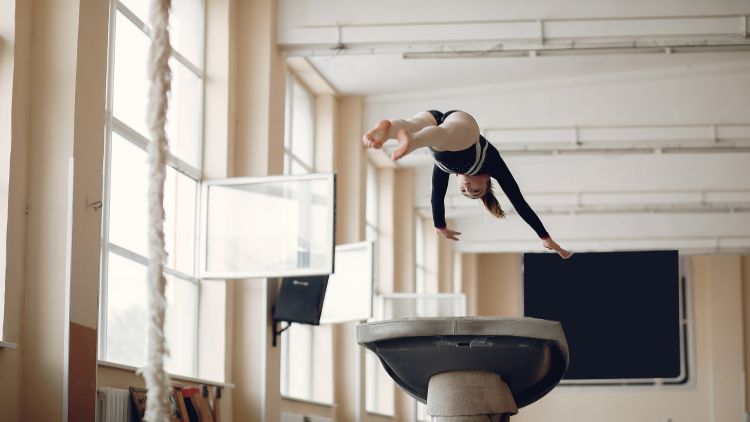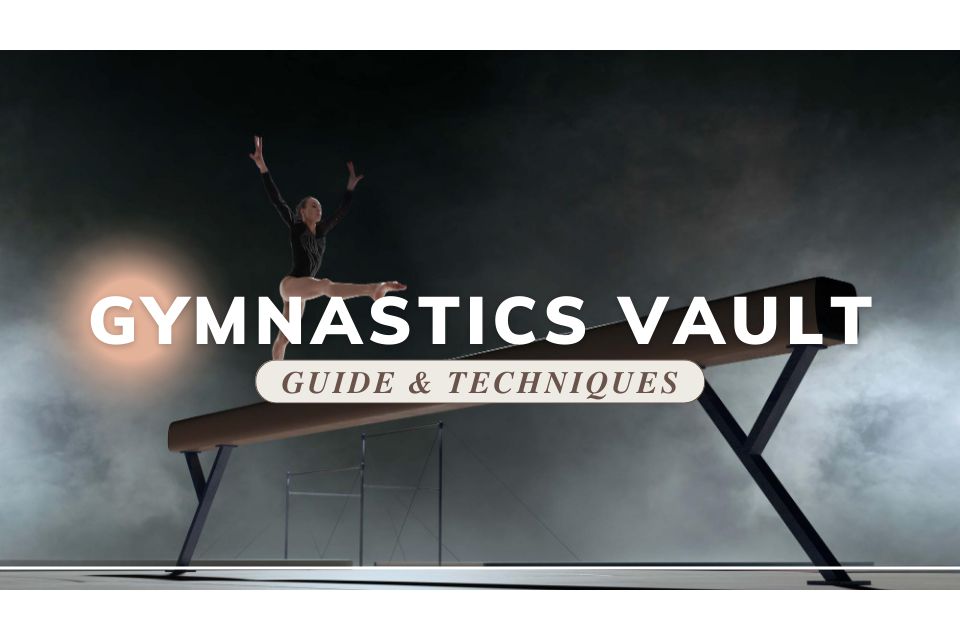A gymnastics vault is a technique classified as artistic gymnastics. But first things first, why is it even called a “vault?” The technique got this name from the equipment gymnasts required to perform it.
This equipment, previously known as the “horse” or “vaulting horse,” was invented by Friedrich Ludwig Jahn in Germany.
But what exactly is the gymnastics vault technique? Let’s find out this and everything else there is to know about this dynamic gymnastics stunt in this post.
What Is A Gymnastics Vault?
So, what is a gymnastics vault, and how do people perform it?
In this artistic gymnastics technique, the athlete sprints down a padded runway. Upon reaching the springboard, they employ momentum to propel themselves upwards. They achieve this using their hands to guide their passage over the vault equipment.
So, vault gymnastics aims to exhibit precise control and finesse while traversing the vault. Moreover, the vault apparatus typically measures 120 centimeters in length and 90 centimeters in width. Ultimately, this presents a challenging yet exciting obstacle for the gymnast to conquer.
However, as a beginner attempting the gymnastics vault, you can use adjustable vault equipment to get the hang of it.
What’s A Vault

We have given you the idea of vaulting, but we still need to answer, “what is a gymnastics vault?”
This is the equipment that makes the technique possible. Vault gymnastics requires a specialized apparatus that Friedrich Ludwig Jahn invented in Germany. Previously this apparatus was called the “vaulting horse.”
Throughout its long history in gymnastics, the vaulting horse was a vital apparatus in the Olympics. It was positioned with its lengthy dimension set perpendicular to the runway for women’s events and parallel for men’s.
Its presence in the Olympics dates back to the inaugural modern games. It featured as the Men’s vault and continued until the 2000 Summer Olympics as a part of the Gymnastics competition.
Vaulting in Gymnastics – Step By Step Guide

The vault is a diverse technique with many variations. Accordingly, competitive gymnasts receive awards depending on their routine’s intricacy and adequate landing.
However, you can try this simple technique if you’re just beginning vault gymnastics. Once you learn to do this, you won’t have to ask, “what is a gymnastics vault?”
1. Running
The beginning of the vault must be calculated ad controlled. So, start by carefully approaching the runway. Moreover, maintain excellent form and even strides as you gather speed approaching the springboard.
2. Leap Off A Springboard
In the second step, it’s time to perform! Use a firm yet controlled jump to launch onto the vaulting table when you reach the springboard. Furthermore, position your foot precisely where you want it on the board to maximize the spring effect.
3. Athletic Manuever on The Table
Push off with your hands in an explosive motion as soon as you contact the vaulting table. Use a dynamic move to demonstrate your talent and technique, such as a handspring or Tsukahara. Also, keep your body taut and straight for the best possible rotation.
4. Landing to Wrap Up Your Gymnastics Vault
Now, you have to wrap up your routine gracefully. This is the most crucial part of the performance. Any mis-maneuvers here and your outstanding run and leap will go to waste.
As you get up from the table and descend, look for the landing to ensure you’re safe. To minimize impact, try to land with your feet together and slightly bent knees. Additionally, maintain your poise and balance while avoiding any steps or hops to ensure a smooth finish.
And voila! You have performed your first vault in gymnastics.
I never get tired of watching this video of Mckayla Maroney. Everything about it is just so perfect. Have a look!
Different Types of Gymnastics Vault
Vault gymnastics is a technique pursued by various athletes regardless of gender. Accordingly, several variations of the maneuver have come forth over the years.
Below is a classification of the different varieties according to the gymnast’s gender.
Gymnastics Vault For Males
Handspring
In a typical Handspring vault, the male gymnast sprints and leaps onto the springboard. Next, he uses the handspring motion to launch himself off the vaulting table.
Tsukahara
In the Tsukahara maneuver, gymnasts use a 180-degree spin onto the hands while passing over the vaulting table.
Kasamatsu
This is a variation of the Yurchenko technique. It involves twisting the hands before contacting the vault. Male gymnasts frequently perform variations of the Kasamatsu vault.
Handspring Double Front
A difficult vault, the Handspring Double Front, requires the gymnast to complete a front handspring and two front somersaults with a twist.
Gymnastics Vault For Females
Yurchenko
This famous vault is performed by rounding off the springboard and then doing a back handspring onto the vaulting table.
Handspring Vault,
Female gymnasts may also do the handspring vault, which entails sprinting and jumping onto the springboard. Next, it entails utilizing a handspring technique to launch oneself off the vaulting table.
Yurchenko Double Full
A complex and stunning vault, the Yurchenko Double Full requires the female gymnast to round off onto the springboard and do two back somersaults while twisting over the vault.
Judging & Scoring in Vault Gymnastics
Vault scoring is a challenging task for judges due to its swift nature. So, a difficulty score and execution score are combined for each vault to determine the total score. Major competitions involve three types of judges, while gymnasts perform two different vaults.
Moreover, the International Gymnastics Federation (FIG) governs judging through the Code of Points. This rule book assigns point values to different skills in international competitions.
The Previous Vault Scoring System
Previously, the maximum score under FIG’s scoring system was 10, or a “perfect 10.” But in 2006, FIG unveiled a brand-new scoring system considering talent and routine difficulty.
The Current Vault Scoring System
Now, a gymnast’s overall score comprises two factors:
- The Difficulty Score (D)
- The Execution Score (E)
The Difficulty Score (D)
The overall difficulty value (DV) of the abilities, connection value (CV), and compositional requirements (CR) is represented by the difficulty score. The D Panel, consisting of two judges, evaluates the Difficulty Score independently before deciding.
The Execution Score (E)
The performance’s execution and artistry are assessed using the Execution Score. The E Panel’s six judges determine this score. They start at ten and subtract points for executional, technical, or artistic mistakes.
History of Vault Gymnastics
Since we have answered, “what is a gymnastics vault?” let’s discover its history now.
The gymnastics vault has been an element of Olympic gymnastics since the inaugural modern games in 1896. Moreover, Friedrich Ludwig Jahn (1778–1852), one of the sport’s founders, created the earliest versions of the equipment. Additionally, Jahn was known for using various gymnastic maneuvers to train Germany’s military prospects.
The vaulting regulations and scoring in 1896 were substantially unlike today. So, gymnasts had a maximum of two minutes to wow the judges by doing as many vaults as possible. The original type of vaults, “horses,” were similar to the pommel horse except for lacking grips.
The Traditional Horse Vault
The goal area on a traditional vault was much smaller. This is because it was bigger but needed more depth.
Also, compared to the modern version, there was a far more significant risk of injury if the hands fell forward or a gymnast came in too low. Ultimately, after the 2000 Olympics, the FIG phased out the old-style broad vault in favor of the table vault due to several mishaps.
Injuries in Gymnastics Vault
While people are interested in asking, “what is a gymnastics vault?” they ignore the risk involved in the maneuver.
Vault gymnastics has been associated with several unfortunate accidents over the years. In 1988, American Julissa Gomez suffered a paralyzing injury during a vaulting accident. Ultimately, she tragically passed away three years later due to complications from her injuries.
Similarly, at the 1998 Goodwill Games, Chinese gymnast Sang Lan fell during warmups and suffered paralysis from a cervical-spine injury.
The 2000 Olympics witnessed a series of crashes when the horse’s height was too low. This caused the gymnasts to collide with the front end or face problematic landings due to hand placement issues during push-off.
Moreover, in 2007, Dutch junior gymnast Imke Glas suffered a severe injury after falling on a vault.
A study conducted in 2021 revealed that the landing scoring criteria in women’s gymnastics increased the risk of injury compared to men’s. This study and an earlier one from 2015 suggested that allowing more flexion at the knees during landing could help reduce impact-related injuries.
Such findings highlight the importance of continually evaluating safety measures to protect gymnasts during this challenge.
Final Words
In conclusion, the vault is a dynamic and challenging technique that requires precise control and finesse. Additionally, the technique and apparatus have improved to prioritize safety and efficiency.
But knowing the answer to “What is a gymnastics vault?” isn’t enough to execute the technique safely.
Vaulting has seen remarkable achievements and moments of brilliance in gymnastics history. However, it has also been associated with severe injuries, prompting ongoing research to enhance safety measures.
So, aspiring gymnasts should approach vaulting with proper training, under expert guidance, and prioritize safety above all else. With dedication and practice, you can master this exciting and essential element of artistic gymnastics.
Happy vaulting!

